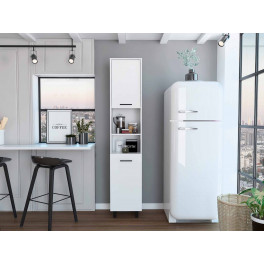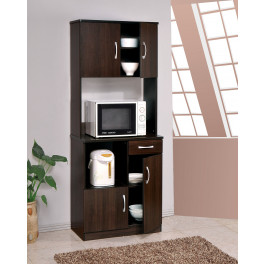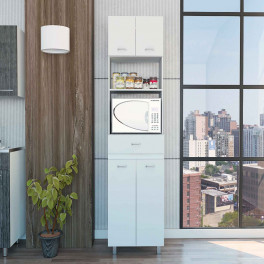So let’s admit it. Anyone who has shopped for dining room furniture has at some point looked at a furniture piece and wondered how to tell if it’s a buffet or a sideboard.
Buffet or sideboard? Hutch or server? Buffet and hutch? Server? Credenza? Aaack! What are these storage and serving pieces called?
Before we give up and start calling all dining room furniture pieces that aren’t tables or chairs, “that other furniture,” let’s see if we can define some of these terms. Knowing what this furniture is called is more than an idle vocabulary lesson. When you understand the various dining room storage and serving furniture options, you can better choose which piece is best for your space when you design your dining room. You’ll be able to determine the winner of the sideboard vs. buffet faceoff … or you’ll realize it really doesn’t matter.
Here are the seven most common pieces of dining room storage and serving furniture.
Buffet
Although many furniture manufacturers use the terms “buffet” and “sideboard” interchangeably, the going consensus about the distinguishing feature between the two has to with leg height. A buffet, generally, is a long narrow cabinet with relatively high legs. Most commonly a traditional dining room piece, the buffet is a frequently seen in neoclassical dining rooms.

Photo by pics721 on Shutterstock
Sideboard
What is a sideboard? A sideboard is basically a buffet with short legs. It, too, is a long, narrow cabinet. The only difference between a sideboard and buffet is how close it sits to the floor. Some sideboards are cabinets that sit directly on the floor, with no legs at all. This type of storage piece can be either traditional or modern in design so it can be included in any dining space.

Photo by pics721 on Shutterstock
Server
A dining room server is a simpler piece of dining room furniture. It’s usually smaller, shorter, and less visually weighty than either a buffet or a sideboard. Designed to live up to its name, a server is intended to be used as a place to hold serving dishes during meals. Essentially, it’s a fancy “counter” for your dining room. Although a server can have cabinets, it can also be just a long, narrow table, similar to a sofa table or an entryway table. And to complicate matters further, this type of server is sometimes referred to as a console table.

Photo by pics721 on Shutterstock
Because it’s a less substantial piece of serving furniture, a dining room server can work well for dining areas in open concept spaces. However, it’s just as well-suited to formal dining rooms.
Credenza
When I think of credenzas, I think of office furniture. However, my research into dining room storage cabinets revealed that credenzas are considered dining room furniture as well. So to muddle the whole buffet or sideboard discussion further, we have to throw the credenza into the mix. A credenza, historically, has been defined as a legless long, narrow cabinet. But the modern credenza can have short legs. Many credenzas have sliding cabinet doors, but hinged doors are possible as well. If any two furniture names are pretty much interchangeable, it’s the sideboard and the credenza.

Photo by pics721 on Shutterstock
Hutch
What is a hutch? My family always referred to the whole dining room storage unit as a hutch, but technically, the “hutch” is just the upper part of the piece. The hutch is the cabinetry that sits on top of the buffet or sideboard. Hutches can be enclosed cabinets, but they’re often glass-fronted cabinets or even open shelving units. Because a hutch can be separated from the buffet or sideboard base it sits on, it’s considered a distinct piece of furniture. Even so, most hutches are sold together with the buffet or sideboard they sit on. Some furniture manufacturers refer to the buffet/sideboard and hutch combination as simply the “hutch.”

Photo by Mark Bonham on Shutterstock
Hutches come in all sorts of styles so they can fit into any dining room large enough to carry the visual weight of a tall, wide piece of furniture. Hutches provide a place to display dining room accessories.
China Cabinet
Some people use the term “china cabinet” for what is actually a “hutch,” and vice versa. A china cabinet, however, truly is a distinct piece of furniture. A china cabinet is one tall unit intended to store china, crystal, or other fine pieces you might want to show off. Because a china cabinet is designed for display, it usually has glass doors and sometimes even glass sides. China cabinets aren’t always located in dining rooms. They can also find their way into living rooms, used as a place to display collectibles.

Photo by Artazum on Shutterstock
Whatever It’s Called
Modern design has gotten pretty creative in dining room spaces. Sometimes stacks of crates are used to store tableware. Sometimes a low or high set of shelves is used. If your dining room storage or serving solution doesn’t fit in one of the above categories, feel free to refer to it as “whatever it’s called.” Or give it a name. Maybe you can come up with some new furniture term to further muddy the dining room furniture waters. Or don’t bother naming it. As long as it holds what you need to store in your dining room, that’s all that matters.

Photo by Monkey Business Images on Shutterstock
Hopefully, this info has clarified the various options you have for dining room storage and serving furniture. To undermine the clarity, however, I have to admit that not all furniture manufacturers and retailers use the same definitions. If you’re looking for a specific type of dining room furniture, therefore, it’s best to do a search for several of the above terms.



























